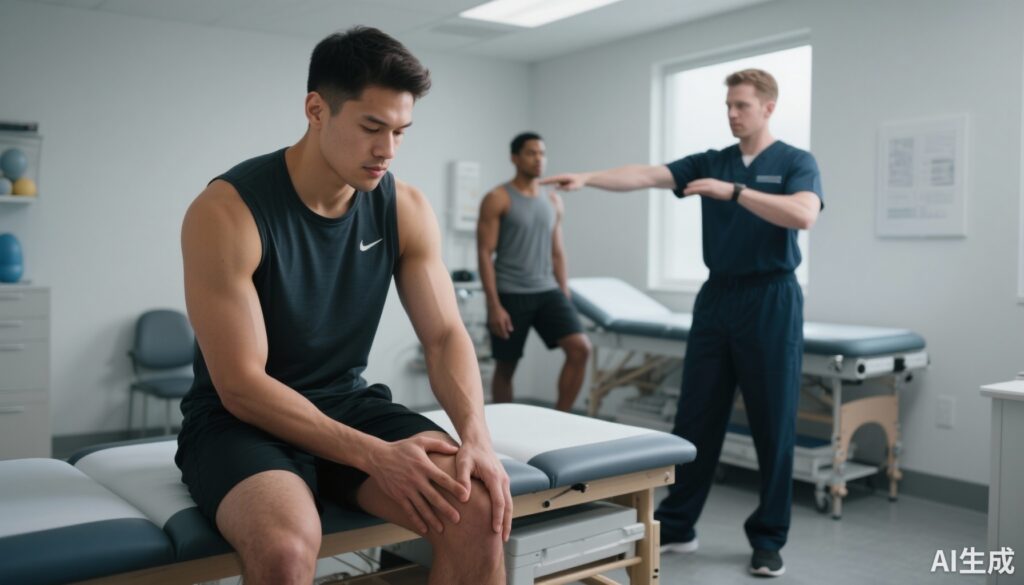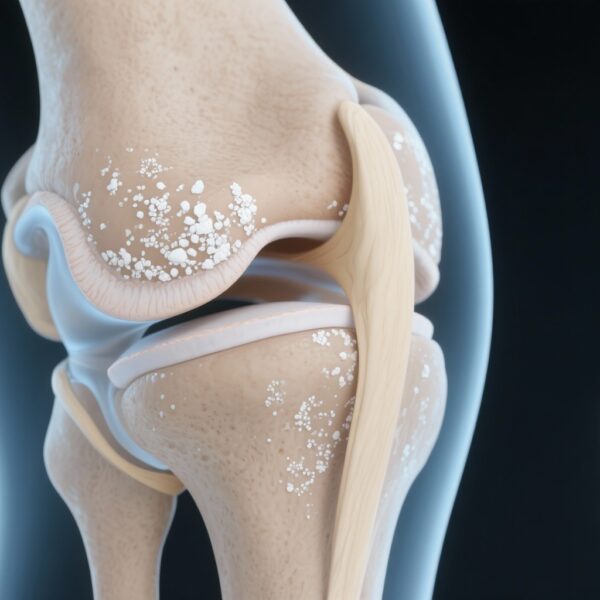Highlight
– In a nationwide Norwegian cohort of 485 patients with primary ACL injury initially managed non-operatively, 63% remained non-operative at 2 years.
– Younger patients (<25 years), those active in pivoting sports, and those with baseline meniscal injuries were more likely to undergo delayed ACL reconstruction (ACLR).
– Instability was the principal indication for delayed ACLR; more than half of delayed reconstructions included meniscal repair.
– Patient-reported knee function (KOOS Sport/Rec and QoL) at 2 years showed moderate impairments but did not differ significantly between patients who stayed non-operative and those who later underwent ACLR.
Background
Anterior cruciate ligament (ACL) rupture is a common knee injury among physically active individuals. Historically, many ACL ruptures were treated surgically to restore stability and allow return to pivoting sports. Over the past two decades, interest in structured rehabilitation with optional delayed reconstruction has increased, recognizing that not all patients require immediate surgery and that a proportion can achieve acceptable function with non-operative care alone. Determining which patients benefit from early reconstruction versus rehabilitation-first strategies remains an important clinical question, with implications for patient outcomes, health-service use, and long-term joint health.
Study design and methods
Kooy et al. used prospectively collected data from the Norwegian Knee Ligament Register (2017–2023) to describe a nationwide population of primary ACL injuries that were initially managed non-operatively. The study included 485 patients with primary ACL rupture documented as initially treated without surgery. Baseline variables included age, activity level, participation in pivoting sports, and presence of meniscal injury at baseline. The authors followed patients to capture delayed ACL reconstruction events, intraoperative findings when reconstruction occurred, and patient-reported outcomes using the Knee injury and Osteoarthritis Outcome Score (KOOS).
Analyses included Kaplan–Meier treatment‑survival curves to estimate the cumulative proportion remaining non-operative over time and Cox proportional hazards regression to identify baseline predictors of undergoing delayed ACLR. KOOS subscale scores at 2 years were compared between patients who remained non-operative and those who later had ACLR.
Key findings
Overall course and delayed reconstruction rates
Of 485 patients initially managed non-operatively (mean age 35 years, SD 12; 25% under 25 years), 63% remained non-operative at 2 years. The majority (93%) reported being physically active in sports before injury, underscoring that this was an active population, not a cohort of sedentary or elderly patients who are automatically poor surgical candidates.
Indications and intraoperative findings for delayed ACLR
Among the 178 patients who underwent delayed ACLR, instability (giving-way symptoms and functional instability limiting activities) was cited as the main reason for surgery in 85% of cases. Intraoperative procedures showed a high burden of meniscal treatment: 56% of delayed reconstructions included a meniscal repair and 18% required partial meniscal resection. These data suggest that meniscal pathology is commonly concurrent or clinically relevant when delayed reconstruction is elected.
Predictors of delayed ACLR
On multivariable Cox regression, the following baseline factors were associated with higher hazard of delayed ACLR:
- Age younger than 25 years: HR 1.95 (95% CI 1.2–3.2)
- Preinjury participation in pivoting sports: HR 1.54 (95% CI 1.1–2.2)
- Meniscal injury at baseline: HR 1.63 (95% CI 1.2–2.2)
These are clinically plausible predictors: younger athletes and pivoting-sport participants often have higher demands for knee stability, and coexisting meniscal injury may predispose to persistent symptoms or mechanical issues prompting surgery.
Patient-reported outcomes
At 2-year follow-up, both groups—those remaining non-operative and those receiving delayed ACLR—had persistent but moderate deficits on KOOS Sport/Rec and KOOS Quality of Life subscales. Mean scores reported were:
- KOOS Sport/Rec: non-operative 69.8 vs delayed ACLR 61.0
- KOOS QoL: non-operative 68.6 vs delayed ACLR 63.4
Although absolute values suggest modestly better scores in the non-operative group, differences were not statistically significant in this cohort. These findings indicate that, at a population level, the mid‑term patient‑reported outcome after a rehabilitation-first strategy with selective delayed reconstruction can be similar to that following delayed reconstruction.
Interpretation and clinical implications
These registry data add real-world evidence that a rehabilitation-first approach is feasible in contemporary practice and that most patients—nearly two-thirds in this series—avoid reconstruction in the short-to-mid term when managed non-operatively initially. The findings align with randomized data from trials (for example, the KANON randomized trial) that showed many patients do well with structured rehabilitation and that early reconstruction may be unnecessary for a substantial subset.
However, clinical decision-making should be individualized. The substantially higher hazard of delayed ACLR in younger patients and pivoting-sport participants supports a tailored approach: clinicians should discuss the higher probability of subsequent surgery with younger athletes and those whose sport requires high knee stability. Baseline meniscal injury also predicts higher likelihood of conversion to surgery; this may reflect persistent mechanical symptoms or progressive meniscal damage that becomes symptomatic.
The high rate of meniscal repairs among delayed reconstructions (56%) highlights two considerations: first, meniscal pathology is common in this group and can influence both symptoms and the need for later surgery; second, surgeons often attempt meniscal preservation when reconstruction is performed, reflecting contemporary practice aimed at protecting long-term joint health.
Strengths and limitations
Strengths
- Large, prospectively collected nationwide registry, increasing generalizability within the studied healthcare system.
- Real-world capture of treatment pathways and intraoperative findings, not limited to specialized centers.
- Use of validated patient-reported outcome measures (KOOS) and survival analyses to describe treatment dynamics.
Limitations
- Selection bias: the cohort includes only patients initially managed non-operatively; it does not represent all ACL-injured patients or randomized allocation to treatment arms.
- Potential confounding by indication: patients and clinicians select non-operative care for reasons that may also relate to prognosis (e.g., activity goals, concomitant injury, patient preference) and these factors may not be fully captured.
- Missing granular data on the exact rehabilitation protocols, objective measures of instability (e.g., instrumented laxity), return-to-sport rates, and long-term structural outcomes (radiographic or MRI markers of osteoarthritis).
- Follow-up limited to two years for the main outcomes; longer-term consequences—particularly osteoarthritis risk—remain uncertain in this cohort.
Expert commentary
Current evidence supports a shared decision-making model for ACL rupture management. For patients with low to moderate functional demands or who are willing to accept activity modification, a structured rehabilitation-first approach with close monitoring is reasonable. In contrast, younger athletes in pivoting sports or patients with symptomatic meniscal lesions at baseline should be counseled regarding a higher likelihood of later reconstruction.
Important clinical practice points include:
- Offer early supervised, criterion-based rehabilitation for all patients as first-line management unless clear clinical or patient preference signals immediate reconstruction.
- Establish explicit clinical thresholds and timelines for considering conversion to ACLR (e.g., persistent instability despite optimized rehab, recurrent giving-way events, failure to return to desired sport).
- Monitor meniscal symptoms carefully; early identification of mechanical symptoms that suggest meniscal tear progression may influence timing of surgery and reparability.
- Discuss realistic expectations about function: even with optimal care, many patients report persistent deficits in sport and quality-of-life domains at two years, emphasizing the need for rehabilitation and possibly sport modification.
Conclusion
In this nationwide Norwegian registry of patients with primary ACL injury initially managed non-operatively, nearly two-thirds remained non-operative at two years. Younger age, preinjury participation in pivoting sports, and baseline meniscal injury raised the probability of undergoing delayed ACL reconstruction. Patient-reported outcomes at 2 years were similar between those who remained non-operative and those who had delayed reconstruction, with moderate impairment persisting in sport and quality-of-life domains. These findings support a rehabilitation‑first, individualized care pathway for many patients while underscoring the importance of shared decision-making for higher-risk subgroups.
Suggested practical checklist for clinicians
1) Assess patient goals: sport level, pivoting activities, occupational demands.
2) Offer structured, supervised, criterion-based rehabilitation as first-line for most patients.
3) Document baseline meniscal status; counsel patients with meniscal tears about increased conversion risk.
4) Reassess with objective functional testing and patient-reported measures at set intervals (e.g., 3, 6, 12 months).
5) Consider ACLR if persistent instability, recurrent giving-way, failure to return to desired level of sport, or mechanical symptoms attributable to meniscal pathology.
Funding and trial registration
The source manuscript is a registry-based study from the Norwegian Knee Ligament Register (Kooy CEVW et al., Br J Sports Med. 2025). Funding and trial registration details were not specified within the abstract-level information provided here; readers should consult the full publication for detailed disclosures.
References
1. Kooy CEVW, Jakobsen RB, Fenstad AM, Persson A, Engebretsen L, Moksnes H, Ekås GR. Non-operative treatment of anterior cruciate ligament injuries: two-thirds avoid surgery at 2-year follow-up in a nationwide cohort. Br J Sports Med. 2025 Oct 15: bjsports-2025-109890. doi:10.1136/bjsports-2025-109890 IF: 16.2 Q1 . Epub ahead of print. PMID: 41093364 IF: 16.2 Q1 .
2. Frobell RB, Roos HP, Roos EM, Ranstam J, Lohmander LS. A randomized trial of treatment for acute anterior cruciate ligament tears. N Engl J Med. 2010;363(4):331–342. doi:10.1056/NEJMoa0907797 IF: 78.5 Q1 .
3. Ardern CL, Taylor NF, Feller JA, Webster KE. Return to sport following anterior cruciate ligament reconstruction surgery: a systematic review and meta-analysis of the state of play. Br J Sports Med. 2011;45(7):596–606. doi:10.1136/bjsm.2009.060972 .



